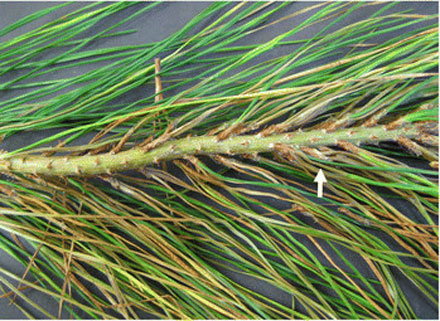
Dieback of pine needles on a pine plantation near the top of the Pahiatua Track prompted Pahiatua resident Ross Cotter to ask the Bush Telegraph why the trees are dying. Source: New Zealand Herald
Pahiatua arborist Kevin Nicholson observed the dieback three years ago.
“It’s affected both younger pine trees and old man pine and has spread south as far as Mangamaire,” he said.
It is likely to be a disease called red needle cast caused by a micro-organism called Phytophthora pluvialis, according to Robert Taylor senior scientist for Ministry for Primary Industries.
“It has been present in New Zealand for many years and is really common throughout the North Island. This area has been sampled many times for this disease.”
Unexplained needle cast events in pine trees have been seen in planted forests in New Zealand since at least the 1950s, according to Scion (former New Zealand Forestry Research.)
In May 2008, a routine forest surveillance check on the East Cape of the North Island found green needles with unfamiliar dark bands, or lesions.
Researchers at Scion visited the site in July and named this potentially new disease red needle cast (RNC), based on the needles turning red and being easily detached.
An unknown species of Phytophthora was confirmed in needles collected from the affected trees shortly afterwards.
In 2012, DNA sequencing matched it with that of Phytophthora pluvialis, a newly-described species from Oregon, USA.
Phosphite fungicides have the potential to be an effective treatment for controlling the disease red needle cast in radiata pine.
According to Farm Forestry New Zealand, in parts of New Zealand shelterbelts, woodlots and commercial plantations suffer from Dothistroma needle blight, Cyclaneusma needle cast, physiological needle blight (PNB), or red needle cast (RNC).
In some regions all four diseases are present. Seasonal development of these diseases differs between diseases, locations, seasons and years.
Many factors, some still to be confirmed, contribute to outbreaks (for instance rainfall, temperature, tree age, silvicultural treatment).
Dothistroma needle blight can be controlled by applying a copper fungicide in October or November.
Timing depends in the location and or season with spray applied earlier in warmer areas. Cyclaneusma is more difficult to control. Susceptible trees can be removed during thinning operations if thinning is undertaken when the disease is showing and the thinning crew can recognise the disease.
Red needle cast and PNB might be controlled by application of a phosphite spray and research is underway to determine this.
Control of needle disease is dependent on the correct identification of the disease. For instance, applying copper spray to control Cyclaneusma needle cast is a waste of time and resources.
The key to identifying needle diseases is to enable farm foresters and other forest growers to be able to identify a needle disease with confidence.
“At this time of the year we do get many reports of pine trees experiencing dieback and previous samples taken from this area have not detected a new disease of biosecurity concern,” Rob Taylor said. “There are also many other physiological, nutritional and pest disorders that cause pine dieback.







